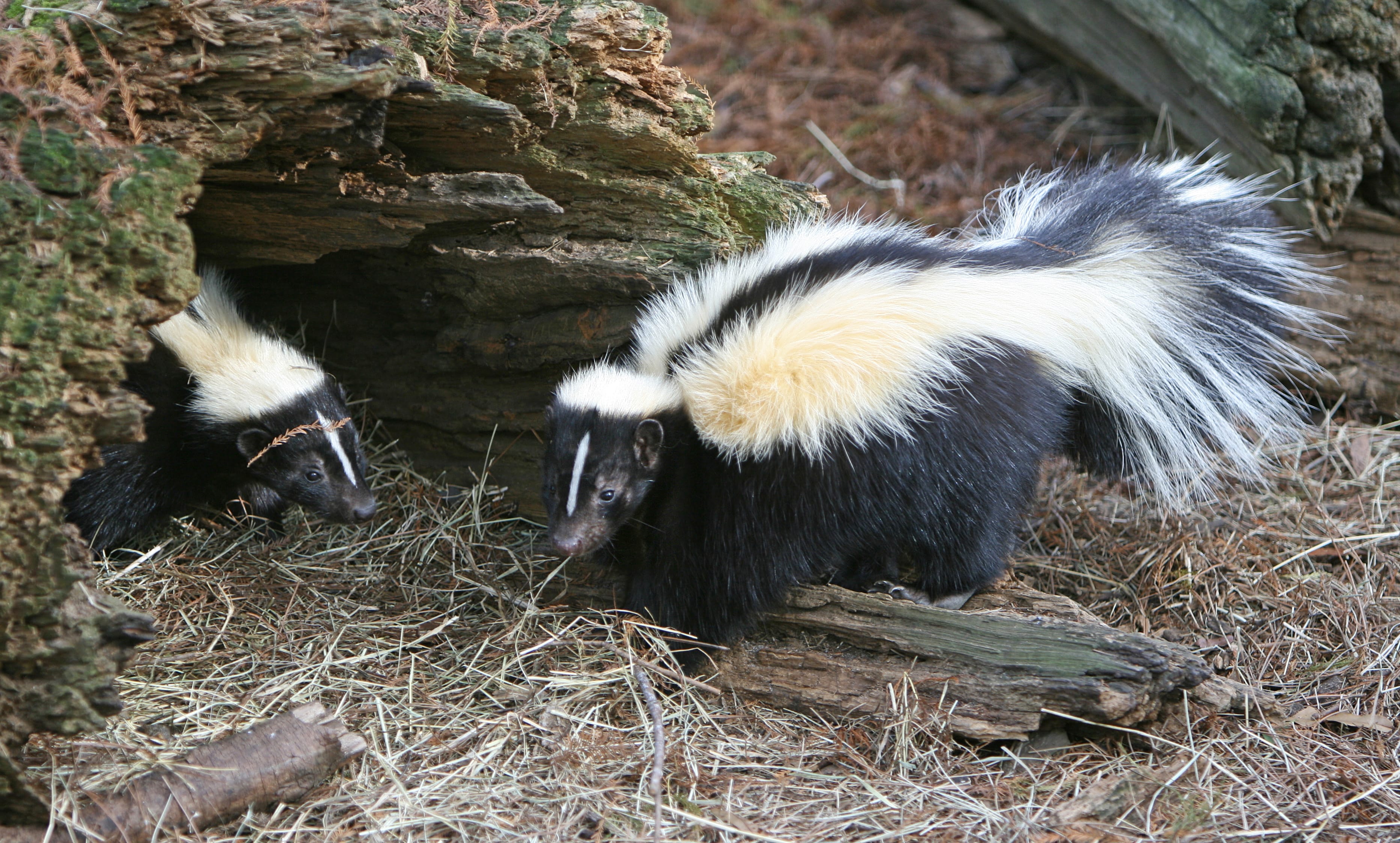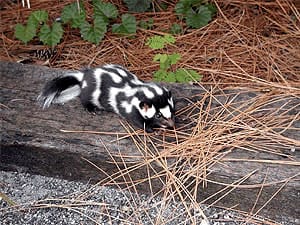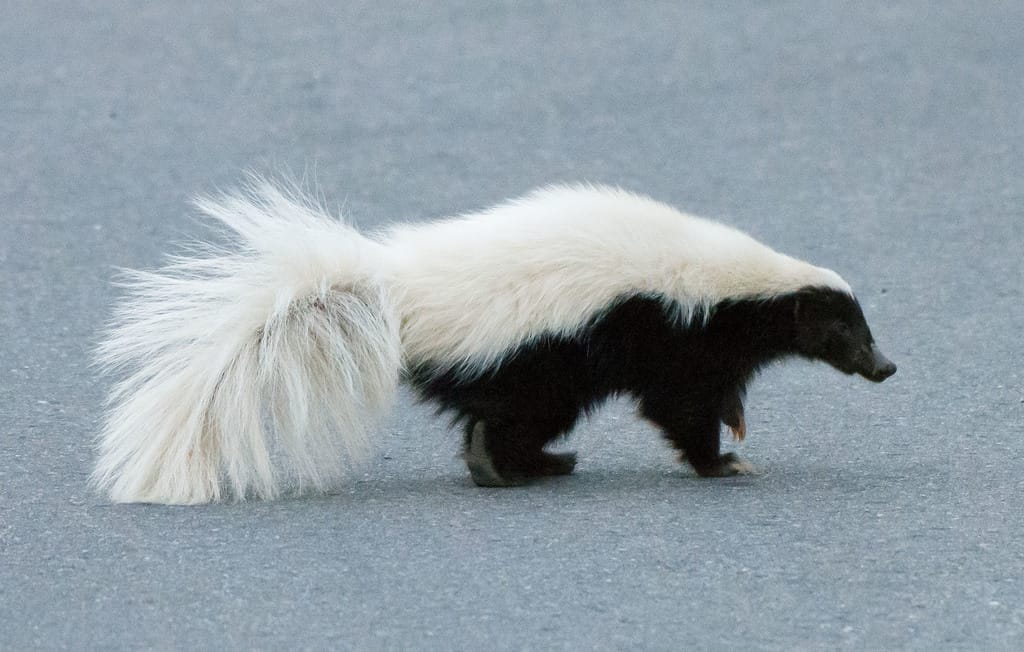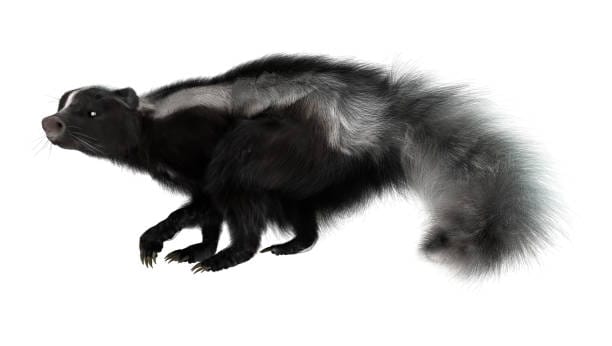Skunks are one of Iowa’s most intriguing nocturnal creatures, easily recognized by their bold patterns and characteristic defensive spray. Although many people think of skunks simply as pests, these small mammals play important roles in controlling insects and small rodents. Iowa is home to several skunk species, each with its own habits, habitats, and quirks. From the ubiquitous striped skunk to rarer spotted and hooded varieties, understanding their behavior, diet, and interaction with humans can enhance both wildlife appreciation and safety. This guide explores 5 Types of Skunks in Iowa, offering a deep dive into their identification, lifestyles, and ecological significance.
Types of Skunks in Iowa
1. Striped Skunk (Mephitis mephitis)

Fun fact: The striped skunk’s signature bold white stripe is a warning sign that most predators wisely heed. Adults weigh between 4–10 pounds and measure 18–34 inches, including their bushy tail. Their glossy black fur and central white stripe are unmistakable, making identification straightforward.
Physical Characteristics & Identification Tips
Striped Skunks are medium-sized mammals with a robust body, short legs, and a bushy tail. Their black fur contrasts sharply with the white dorsal stripe, which starts at the head and may split near the shoulders. They have sharp claws for digging and strong, muscular forelimbs. Sexual dimorphism is subtle; males are slightly larger than females, but both sexes share similar markings.
Behavior
Primarily nocturnal, striped skunks are slow-moving but clever foragers. They use a combination of smell, touch, and hearing to locate food at night. Their characteristic spray is a last-resort defense mechanism, accompanied by warning stomps and hisses. Striped skunks are solitary for most of the year, though males may roam extensively during mating season.
Habitat and Range
These skunks are adaptable, found in forests, grasslands, agricultural areas, and suburban neighborhoods throughout Iowa. They prefer areas with ample cover, such as brush, rock piles, or abandoned burrows, and can occasionally be spotted near roadsides and gardens.
Diet
Omnivorous by nature, striped skunks feed on insects, larvae, small mammals, eggs, fruits, and occasionally carrion. One might see them pawing at the soil or flipping over logs in search of grubs, which helps reduce pest populations naturally.
Reproduction and Life Cycle
Breeding occurs from late winter to early spring. After mating, females give birth to 4–7 kits in early summer. Kits are born blind and helpless, but they grow quickly, emerging from the den at about six weeks. By fall, young skunks are typically independent and ready to face Iowa winters.
Fun Facts / Unique Traits
Striped skunks have a highly developed sense of smell, which they use to locate prey underground. Their spray can travel up to 10 feet, with an odor that can linger for days. Interestingly, predators such as great horned owls can hunt them successfully, avoiding the spray altogether.
Human Interaction
These skunks are mostly harmless but can pose issues when they dig in gardens or nest under sheds. Proper waste management and sealing entry points around homes can reduce conflicts. Observing them from a distance can provide insights into their fascinating nocturnal activities without risk.
2. Eastern Spotted Skunk (Spilogale putorius)

Fun fact: Spotted skunks can perform a “handstand” warning display when threatened, a theatrical behavior rarely seen in other wildlife. Adults are smaller than striped skunks, usually weighing 1–2 pounds and measuring 16–20 inches long.
Physical Characteristics & Identification Tips
Eastern Spotted Skunks have a slender body, with broken white stripes or spots running down their back and flanks. Their tails are bushy but shorter than striped skunks. Agile and nimble, they are excellent climbers, often using trees and fences to escape danger.
Behavior
Primarily nocturnal and crepuscular, these skunks forage at night. Their handstand display is combined with foot stamping and hissing to warn predators before deploying their potent spray. Unlike striped skunks, they are more agile and capable of quick bursts of climbing or running.
Habitat and Range
Eastern Spotted Skunks historically occupied forests, grasslands, and farmland edges. Their numbers have declined in Iowa, but they are still occasionally observed in rural and semi-wooded areas. They often seek shelter in rock crevices, hollow logs, or abandoned burrows.
Diet
They are opportunistic feeders, consuming insects, rodents, eggs, fruits, and berries. Their diet varies seasonally; in spring and summer, insects dominate, while in fall, fruits and seeds become more important.
Reproduction and Life Cycle
Breeding occurs in early spring. Females give birth to 2–6 kits in concealed dens. Kits open their eyes after about two weeks and begin exploring outside the den by six weeks. Independence usually follows by late summer.
Fun Facts / Unique Traits
Known for their agility, Eastern Spotted Skunks can scale vertical fences or even climb trees. Their handstand warning display is a remarkable defensive behavior that sets them apart from other Iowa skunks.
Human Interaction
Spotted Skunks rarely enter human dwellings due to their small size and secretive nature. However, they sometimes forage near barns or gardens. Maintaining clean yards and securing food sources minimizes unwanted encounters.
3. Plains Spotted Skunk (Spilogale interrupta) – Rare / Historical

Fun fact: Plains Spotted Skunks have distinctive broken stripes and small white spots, making them appear almost patterned for camouflage in grasslands. They are smaller than striped skunks, typically weighing 1–2 pounds.
Physical Characteristics & Identification Tips
This skunk is slender, with a small, pointed face and large eyes for nocturnal vision. The fur pattern includes broken stripes along the back and white spotting along the sides. They have a bushy tail, though proportionally shorter than striped skunks.
Behavior
These skunks are primarily nocturnal, using stealth and agility to forage for insects and small prey. Like other spotted skunks, they employ handstand displays and foot-stomping to warn predators before spraying.
Habitat and Range
Historically found in Iowa’s western grasslands, Plains Spotted Skunks are rarely observed today. Their preferred habitats include open prairies, farmland edges, and areas with dense grass or shrubs for cover.
Diet
Omnivorous, they primarily feed on insects, small mammals, eggs, and occasionally berries or fruits. Their diet adapts seasonally depending on availability of prey and plant matter.
Reproduction and Life Cycle
Breeding occurs in spring. Females give birth to 3–6 kits in hidden dens, often in abandoned burrows or under dense vegetation. Kits are dependent for about six weeks before becoming independent.
Fun Facts / Unique Traits
Plains Spotted Skunks are particularly elusive. Their patterned fur acts as a natural camouflage in tall grasses, reducing predation risk and making them harder to spot.
Human Interaction
Due to their rarity, Plains Spotted Skunks have limited interactions with humans. Observing them in the wild requires patience and respect for their secretive nature.
4. Hooded Skunk (Mephitis macroura) – Rare / Accidental Sightings

Fun fact: The Hooded Skunk gets its name from the elongated white stripe that runs from its head down the neck, resembling a “hood” draped over its shoulders. Adults typically weigh 3–6 pounds and measure around 18–28 inches, including the tail.
Physical Characteristics & Identification Tips
Hooded Skunks are medium-sized with a black coat accented by a prominent white “hood” stripe. Their tails are bushy but less dramatic than those of striped skunks. They have strong forelimbs for digging and sharp claws, and their face is narrow with large dark eyes adapted for nocturnal activity.
Behavior
Primarily nocturnal, Hooded Skunks are solitary and cautious. They rely on stealth to forage for insects, small mammals, and eggs. When threatened, they lift their hooded back and perform warning hisses or sprays. Their agility allows them to escape predators more easily than the slower striped skunks.
Habitat and Range
Although native to the southwestern United States, there have been occasional accidental sightings of Hooded Skunks in Iowa, likely due to human-mediated movement or rare migration. They prefer brushy areas, abandoned burrows, and edges of farmland where they can find cover and food.
Diet
Omnivorous by nature, they feed on insects, worms, small rodents, eggs, fruits, and berries. During the winter, they may rely more on plant matter and cached food as insect activity declines. Their diet helps control pest populations naturally.
Reproduction and Life Cycle
Breeding occurs in late winter or early spring. Females give birth to 3–6 kits in hidden dens. Kits develop quickly, opening their eyes in about two weeks and venturing outside the den by six weeks. Independence is typically achieved by late summer or early fall.
Fun Facts / Unique Traits
Hooded Skunks are surprisingly elusive and adaptive. The “hood” stripe serves both as a visual warning and as camouflage when navigating wooded or grassy habitats. Their long legs allow them to run faster and climb slightly more effectively than other skunks.
Human Interaction
Because they are rare in Iowa, Hooded Skunks have minimal direct interaction with humans. Gardeners and wildlife enthusiasts may occasionally spot one, usually at night. Keeping food sources secured and observing from a distance prevents conflicts while allowing appreciation of their fascinating behavior.
5. Hog-nosed Skunk (Conepatus leuconotus) – Rare / Introduced Records

Fun fact: Hog-nosed Skunks are named for their large, flat snouts, which they use like shovels to dig out insects and grubs from the soil. They are larger and more robust than spotted skunks, weighing 5–10 pounds and measuring 20–30 inches.
Physical Characteristics & Identification Tips
Hog-nosed Skunks have a stocky body with a distinctive flat, broad nose adapted for digging. Their black coat is contrasted by white markings, usually a central stripe that widens at the shoulders. They have large, strong claws for foraging underground and a bushy tail that can signal alarm.
Behavior
These skunks are nocturnal and solitary, using their keen sense of smell to locate prey. They are strong diggers, sometimes leaving noticeable holes in lawns or fields while hunting for insects. When threatened, they can spray their musk up to 10 feet, but they often give visual warnings first.
Habitat and Range
Primarily native to the southwestern and southern U.S., Hog-nosed Skunks have been recorded rarely in Iowa, particularly near the Missouri River. They prefer open grasslands, prairies, and farmland edges with loose soil suitable for digging.
Diet
Omnivorous with a strong preference for invertebrates, Hog-nosed Skunks feed on insects, grubs, worms, and occasionally small vertebrates. They supplement their diet with fruits, seeds, and carrion, especially when insect populations are low.
Reproduction and Life Cycle
Breeding occurs in early spring. Females produce 3–6 kits, which remain in the den until they are developed enough to forage independently. Kits are usually fully independent by late summer and ready to establish their own territories.
Fun Facts / Unique Traits
The Hog-nosed Skunk’s digging behavior makes it a natural pest controller. Its flattened snout and strong claws are specialized adaptations that allow it to root out insects deep underground. Despite its appearance, it is non-aggressive toward humans unless cornered.
Human Interaction
Hog-nosed Skunks are rarely seen by people in Iowa due to their scarcity. When observed, they are mostly active at night. Farmers and gardeners may occasionally notice small digging marks, but conflicts are minimal. Respectful observation ensures safety for both humans and skunks.
Frequently Asked Questions About Skunks in Iowa
1. How many types of skunks are in Iowa?
Iowa is home to 5 types of skunks, including the common Striped Skunk and the rarer Eastern Spotted, Plains Spotted, Hooded, and Hog-nosed Skunks.
2. What is the most common skunk in Iowa?
The Striped Skunk is the most common skunk species found throughout Iowa.
3. Are Eastern Spotted Skunks found everywhere in Iowa?
Eastern Spotted Skunks are historically present in Iowa, but their populations have declined, making sightings less frequent than striped skunks.
4. Do skunks in Iowa pose a risk to humans?
Skunks are generally non-aggressive, but their spray can be very unpleasant. Avoid handling them and keep pets away.
5. What do skunks in Iowa eat?
Iowa skunks are omnivorous, feeding on insects, small mammals, eggs, fruits, and occasionally human food scraps.
6. Where do skunks in Iowa live?
Skunks inhabit forests, grasslands, prairies, farmland edges, and even suburban areas where cover and food are available.
7. Can skunks in Iowa climb trees?
Spotted skunks in Iowa are agile climbers and can sometimes escape predators by climbing fences or small trees, whereas striped skunks are primarily ground dwellers.
8. How do I identify a skunk in Iowa?
Look for distinctive black-and-white markings: striped skunks have a central stripe, while spotted skunks have broken stripes or spots. Body size, tail shape, and nose shape can also help.
9. When do skunks in Iowa breed?
Most Iowa skunks breed in late winter to early spring, with kits born in spring or early summer.
10. How many kits do skunks in Iowa have?
Skunks in Iowa typically have 2–7 kits per litter, depending on the species and environmental conditions.
11. Are skunks in Iowa nocturnal?
Yes, all Iowa skunks are primarily nocturnal, becoming active at dusk and throughout the night.
12. Can I keep a skunk as a pet in Iowa?
In most cases, keeping a skunk as a pet in Iowa is illegal unless you obtain special permits from wildlife authorities.
13. Do skunks in Iowa hibernate?
Skunks do not hibernate fully but become less active in winter, often staying in dens during extreme cold.
14. How far can a skunk spray in Iowa?
A skunk can spray up to 10 feet, with a strong odor that may last for days if not cleaned properly.
15. Are there any rare skunks in Iowa?
Yes, Plains Spotted, Hooded, and Hog-nosed Skunks are considered rare or accidental sightings in Iowa.
16. What predators eat skunks in Iowa?
Great horned owls, coyotes, and bobcats occasionally prey on skunks, as they can avoid the skunk’s spray with caution.
17. Do skunks in Iowa dig up gardens?
Yes, skunks may dig for insects, grubs, and worms, which can disturb lawns and gardens.
18. How can I deter skunks from my Iowa property?
Secure trash, close entry points to crawl spaces, and remove food sources like pet food or fallen fruit to deter skunks.
19. Are Hog-nosed Skunks common in Iowa?
No, Hog-nosed Skunks are very rare in Iowa and mostly occur near the Missouri River as occasional strays.
20. How do skunks in Iowa defend themselves?
Skunks warn predators with hisses, foot stomps, and their characteristic black-and-white markings before spraying musk as a last resort.
21. Are skunks beneficial in Iowa?
Yes, skunks help control insect and rodent populations, acting as natural pest managers in both rural and suburban areas.
22. Can skunks swim in Iowa?
Yes, skunks can swim if necessary, although they typically prefer dry habitats and will avoid water when possible.
23. How long do skunks live in Iowa?
In the wild, Iowa skunks generally live 3–4 years, though some can survive up to 7 years under favorable conditions.
24. Are spotted skunks endangered in Iowa?
Eastern Spotted Skunks have declined in Iowa but are not federally endangered. Conservation efforts focus on habitat preservation.
25. How can I safely observe skunks in Iowa?
Use binoculars or cameras from a safe distance at night, and avoid approaching their dens or startling them.
26. Do skunks in Iowa carry diseases?
Skunks can carry rabies, so it is important to avoid contact and vaccinate pets regularly.
27. When are skunks most active in Iowa?
Skunks are most active from dusk to dawn, with peak foraging occurring during the early evening and pre-dawn hours.
28. Do skunks migrate in Iowa?
No, skunks in Iowa are generally non-migratory and maintain territories throughout the year.
29. How can I tell the difference between a striped and a spotted skunk in Iowa?
Striped skunks have continuous central stripes, while spotted skunks have broken stripes or spots along the back and sides, and are smaller and more agile.
30. Can I feed skunks in Iowa?
Feeding wild skunks is not recommended, as it can encourage dependency, human conflicts, and potential disease transmission.
31. Are Hooded Skunks aggressive in Iowa?
Hooded Skunks are rarely seen in Iowa and are generally non-aggressive, using spray only when threatened.
32. Why are skunks black and white in Iowa?
The black-and-white coloration serves as a warning to predators (aposematic coloring), signaling that the skunk can spray a noxious chemical if attacked.
33. How do skunks in Iowa mark their territory?
Skunks mark territory using scent glands, leaving chemical signals to communicate presence and reduce conflicts with other skunks.
Conclusion
Skunks in Iowa are fascinating creatures that play an important role in maintaining ecological balance. From the ubiquitous Striped Skunk to the rarely seen Hooded and Hog-nosed Skunks, each species brings its own set of behaviors, adaptations, and ecological contributions. While their signature defensive spray often makes them the subject of caution or humor, these nocturnal mammals help control insect and rodent populations, benefiting both natural habitats and human environments.
Observing skunks safely from a distance allows us to appreciate their nocturnal routines, digging behaviors, and social interactions without disturbing them. For gardeners, homeowners, and wildlife enthusiasts in Iowa, understanding the habits and needs of these skunks can prevent conflicts and foster a respectful coexistence. Whether you spot a striped stripe dashing across a field or a rare spotted skunk in a wooded edge, each encounter is a reminder of Iowa’s rich biodiversity and the subtle yet significant role skunks play in the ecosystem.
In essence, skunks in Iowa are more than just their notorious spray—they are skilled foragers, adaptable survivors, and an essential part of the state’s wildlife community. By learning about and respecting them, we can enjoy the unique charm and ecological value that these nocturnal mammals offer.
Read more: 5 Types of Skunks in Kansas (Pictures and Identification)
